Meteorcomm 63010 Wayside Packet Data Transceiver User Manual ITCR Wayside Radio User s Guide
Meteorcomm LLC Wayside Packet Data Transceiver ITCR Wayside Radio User s Guide
Contents
- 1. Users Manual Draft 7
- 2. Users Manual
Users Manual

ITCR Wayside Radio
User's Manual and Installation
Instructions
Applicable Model: 63010
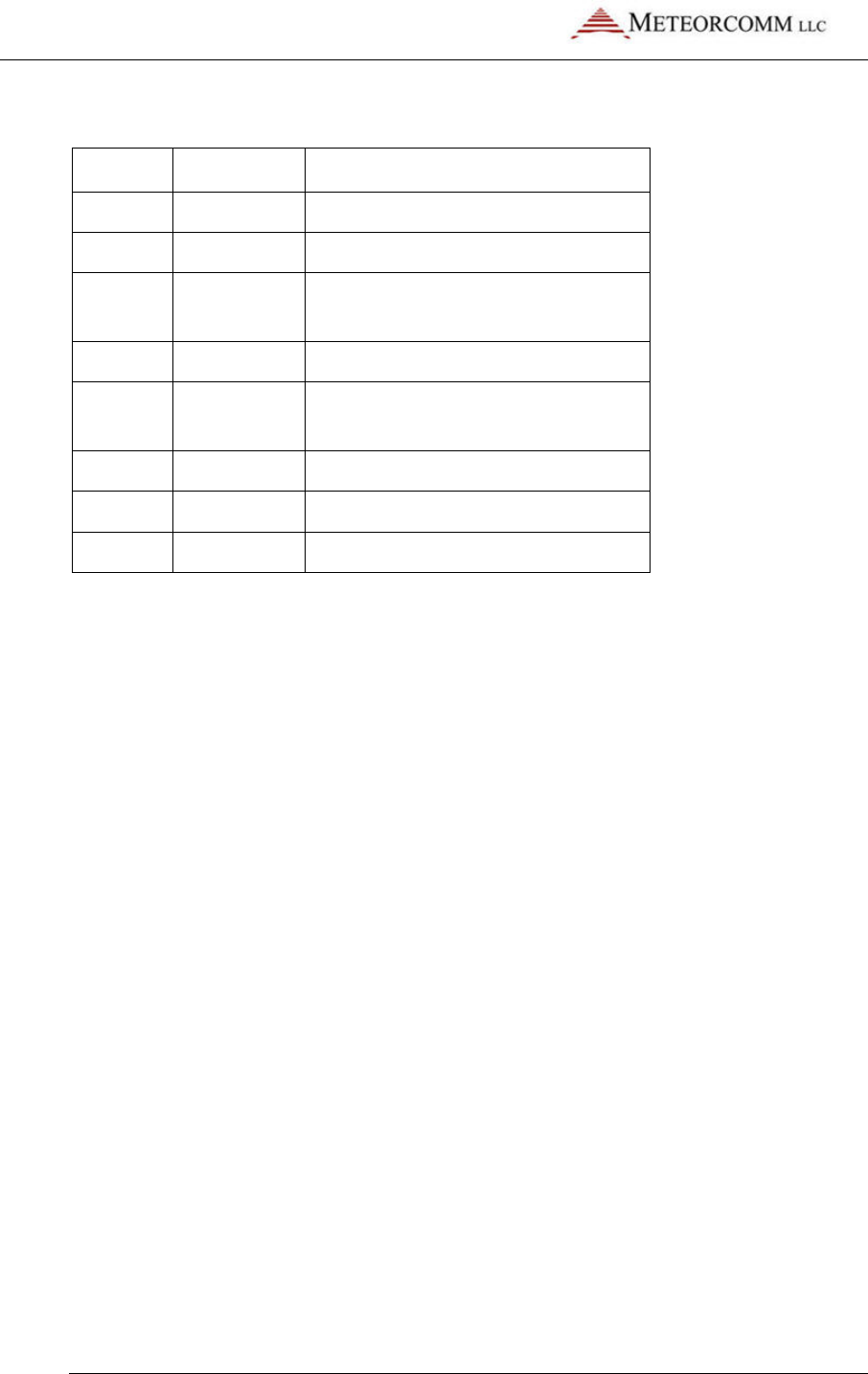
ITCR Wayside User’s Manual
© 2013 Meteorcomm LLC. All Rights Reserved. Proprietary and Confidential
ii 5/16/2013
Revision History
Revision Date Summary of Changes
0.1
Initial draft.
0.2
Changes by Jeff Lawrence
0.3
08/29/2011
Added Notices to user, renamed
and edited for FCC submission
0.4
09/08/2011
Fixed errors and omissions.
0.5
10/04/2011
Expanded and edited in response
to examiner comments.
0.6
10/06/2011
Corrected voltages.
0.7
10/20/2011
Revised Section 2.2, 3.3 and 5.4
1.0
5/16/2013
Update to add new frequencies

ITCR Wayside User’s Manual
© 2013 Meteorcomm LLC. All Rights Reserved. Proprietary and Confidential
5/16/2013 iii
Table of Contents
1. Overview ............................................................................................................................. 1
1.1 Applicable Radio Models and Identifiers ................................................................ 1
1.2 General Description ................................................................................................ 1
1.3 Chassis ..................................................................................................................... 2
1.4 Ports and Ethernet Connectors .............................................................................. 2
1.5 Power Connectors ................................................................................................... 2
1.6 Antenna Connectors ............................................................................................... 2
2. Important Information for the User ................................................................................... 2
2.1 Transmitter Warm-Up Period. ................................................................................ 2
2.2 Limiting RF Exposure ............................................................................................... 3
2.3 Antenna Guidelines ................................................................................................. 3
2.4 RF Interference to Residential Receivers (Part 15) ................................................. 4
2.5 Equipment Modifications ....................................................................................... 5
3. Wayside Transmitter Operation ......................................................................................... 5
3.1 Wayside Channelization and Frequency Range ...................................................... 5
3.2 Wayside Channel Restrictions ................................................................................ 5
3.3 Wayside Radiated Power Limits ............................................................................. 6
4. Setup and Configuration for the Wayside Radio ................................................................ 7
4.1 Power Supply .......................................................................................................... 8
4.2 Ethernet Connection ............................................................................................... 8
4.3 RF Output Termination ........................................................................................... 8
5. Tuning the Wayside Radio .................................................................................................. 9
5.1 Equipment Required ............................................................................................... 9
5.2 Set up the Radio for Testing ................................................................................... 9
5.3 Measure and Calibrate Reference Crystal Oscillator Frequency .......................... 10
5.4 Measure and Adjust Output Power ...................................................................... 11
5.5 Check and Adjust RF Output Channel ................................................................... 12
6. Operations ........................................................................................................................ 13
6.1 Restore Factory Settings ....................................................................................... 13
6.2 Display Software and Firmware Revision Numbers ............................................. 13

ITCR Wayside User’s Manual
© 2013 Meteorcomm LLC. All Rights Reserved. Proprietary and Confidential
iv 5/16/2013
6.3 Display Radio Identification Information .............................................................. 13

ITCR Wayside User’s Manual
© 2013 Meteorcomm LLC. All Rights Reserved. Proprietary and Confidential
5/16/2013 1
1. Overview
This document provides information required for the operation and verification of
the Meteorcomm Interoperable Train Control Radio Network (ITCR) Wayside radios.
1.1 Applicable Radio Models and Identifiers
This document applies to the Wayside radio model listed below along with its
regulatory identifiers.
Model: 63010
FCC ID: BIB63010
IC: 1300A-63010
1.2 General Description
The Wayside radio is designed to satisfy the industry standard Positive Train Control
(PTC) requirements as part of an integrated 220 MHz radio network. The Base radio,
Locomotive radio, and Wayside radio form the transportation backbone on which a
messaging application provides communication capabilities between railroad assets
and their back offices. The ITCR is designed to provide communication in an inter-
operable fashion enabling messaging to occur across railroad boundaries.
When applied as a mobile station, this radio will be mounted in mobile maintenance
vehicles such as pickup trucks. It will actively join the ITC network only when
maintenance vehicles are driven on the rails.
The Wayside radio is normally positioned on railroad property in an equipment box
or bungalow close to the active rails. When used as a wayside station, its mission is
to provide wireless transmission of local track and trackside equipment where it is
mounted. Its radio messages are actively monitored by locomotives in the vicinity
that may be headed in its direction. It also normally associates with a nearby base
station. The base station backhauls the wayside transmission for various monitoring
and control purposes at the railroad central office. It is normally interfaced to a
Wayside Interface Unit (WIU) via its LAN ethernet port. The WIU terminates all local
wayside equipment such as switches, signals, track continuity circuits and several

ITCR Wayside User’s Manual
© 2013 Meteorcomm LLC. All Rights Reserved. Proprietary and Confidential
2 5/16/2013
other possible track condition indicators. The WIU formats the status information
into a short message called an aspect. The aspect is sent to the Wayside radio for
packetized RF transmission.
1.3 Chassis
Wayside radios are housed in electrically sealed metal cases. The Wayside radio
dimensions are approximately 15.5W X 9.5 H X 2.0D. It weighs less than 8 lbs.
All input/output ports are grounded and/or shielded. In addition, best engineering
practices have been employed with respect to internal shielding, unit assembly and
PCB design in an effort to minimize potential sources of unwanted radiated
emissions.
1.4 Ports and Ethernet Connectors
The Wayside radio has two RJ45 Ethernet I/O ports, marked LAN and MAINT, each
on its own network.
1.5 Power Connectors
The Wayside radio power input connector is a Wago type for 13.6 VDC nominal, min
10.9 VDC and max 15.5 VDC.
1.6 Antenna Connectors
The 30W PEP rated 220-222 MHz wayside radio transmitter has an N-type antenna
connector and expects a nominal 50 ohm resistive load, max VSWR 3:1. It also has a
TNC connector for the GPS antenna. The GPS antenna can be active (3.3Vdc, 50mA
max) or passive.
2. Important Information for the User
2.1 Transmitter Warm-Up Period.
The wayside transmitter uses a temperature compensated crystal oscillator (TCXO)
to achieve frequency accuracy and stability. No warm-up period is required beyond
the built-in radio startup delays.
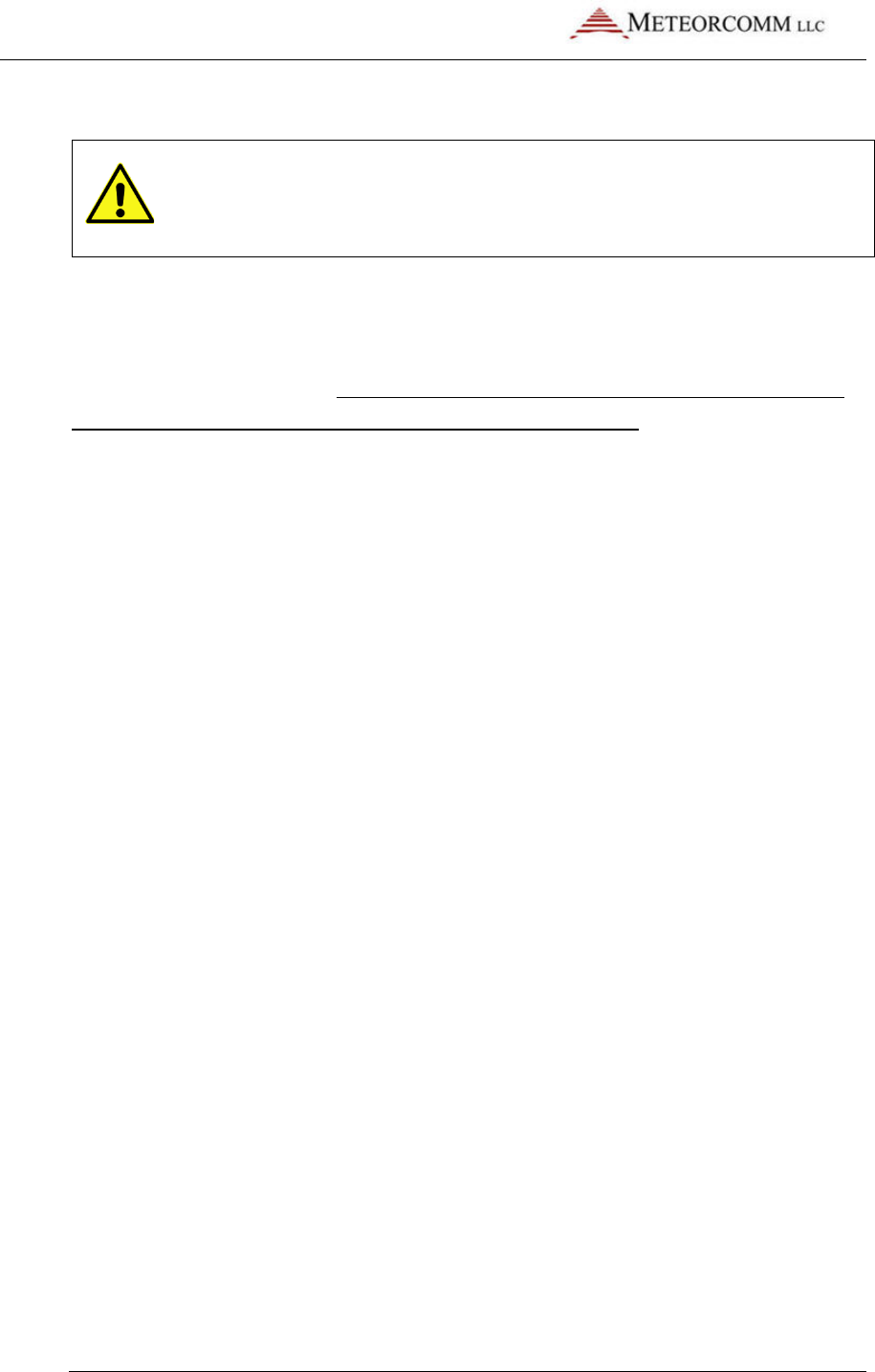
ITCR Wayside User’s Manual
© 2013 Meteorcomm LLC. All Rights Reserved. Proprietary and Confidential
5/16/2013 3
2.2 Limiting RF Exposure
Please refer to the RF Energy Exposure Guide packed with each radio for
specific information regarding safe distances that must be maintained
between personnel and energized transmitting antennas.
The information in the RF Energy Exposure Guide is determined from FCC and
Industry Canada rules that when followed, limit human exposure to radio frequency
energy to acceptable levels. Note that the RF Energy Exposure Guide calculates the
larger lateral safe distances for an uncontrolled environment. Obeying these limits
will protect both railroad employees and the general public.
This radio is intended for use by railroad employees who have full knowledge of
their exposure and can exercise control over their exposure to meet FCC and IC
limits. This radio device is not intended for use by consumers or the general
population.
This transmitter is intended to be operated with a fixed or mobile antenna in an
Occupational/Controlled Exposure environment per FCC OET 65 or Controlled Use
Environment per IC RSS-102. Maximum Permitted Exposure (MPE) limit for devices
in the presence of the general public in the 100-300 MHz range is 0.2 mW/cm2 = 2
W/m2.
The tables in the RF Energy Exposure Guide list the calculated lateral distances to be
maintained between the general public and an operational Wayside transmitter
antenna for two antenna types and gains and for both fixed and mobile applications.
The transmitter power is adjustable to accommodate the various installations of this
product. Once the authorized ERP, antenna gain and the losses from feed line,
connectors and any inline RF filters are known, the transmitter power must be
evaluated and if necessary, set to a value that will ensure that the authorized ERP
and RF exposure requirements are met. Example ERP calculations are provided
further below.
2.3 Antenna Guidelines
This section contains antenna information and additional notes regarding methods
to limit RF exposure.

ITCR Wayside User’s Manual
© 2013 Meteorcomm LLC. All Rights Reserved. Proprietary and Confidential
4 5/16/2013
• The licensee is required to comply with limits on antenna location, power and
effective antenna height per 47CFR Subpart T §90.701 et. seq., or Industry
Canada SRSP-512 §6.3 as applicable.
• Install antennas in accordance with the manufacturer’s instructions.
• Disable the transmitter when installing or servicing its antenna or transmission
line.
• Refer to the RF Energy Exposure Guide for specific guidelines regarding the
siting and installation of mobile and fixed antennas.
• Acceptable mobile and fixed antenna types are listed in the tables in the RF
Energy Exposure Guide.
• Unauthorized antennas, equipment modifications or attachments could
invalidate any equipment warranty or authority to transmit. Modification could
damage the radio and may violate FCC or IC regulations. Contact Meteorcomm
before using other antennas.
• Maintain a safe distance from energized transmitting antennas. See above.
2.4 RF Interference to Residential Receivers (Part 15)
NOTICE TO USER: This device complies with part 15 of the FCC Rules. Operation is
subject to the condition that this device does not cause harmful interference.
NOTE: This equipment has been tested and found to comply with the limits for a
Class B digital device, pursuant to Part 15 of the FCC Rules. These limits are
designed to provide reasonable protection against harmful interference in a
residential installation. This equipment generates and can radiate radio frequency
energy and, if not installed and used in accordance with the instructions, may cause
harmful interference to radio communications. However, there is no guarantee that
interference will not occur in a particular installation. If this equipment does cause
harmful interference to radio or television reception, which can be determined by
turning the equipment off and on, the user is encouraged to try to correct the
interference by one or more the following measures:
• Reorient or relocation the receiving antenna.
• Increase the separation between the equipment and receiver.
• Connect the equipment into an outlet on a circuit different from that to which
the receiver is connected.
• Consult the dealer or an experienced radio/TV technician for help.
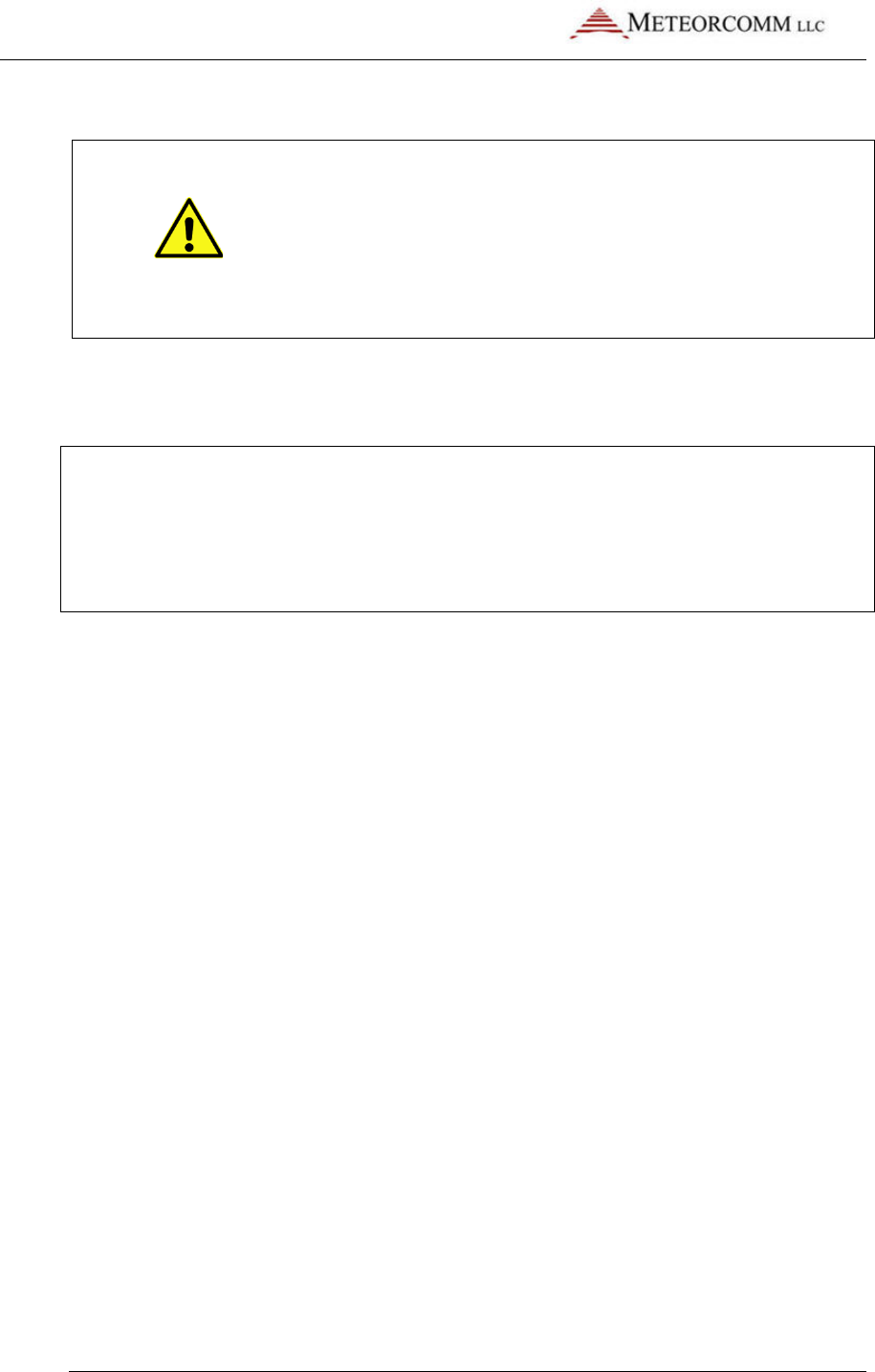
ITCR Wayside User’s Manual
© 2013 Meteorcomm LLC. All Rights Reserved. Proprietary and Confidential
5/16/2013 5
2.5 Equipment Modifications
Caution: Any changes or modifications to this equipment
not expressly approved by the party responsible for
compliance (in the respective country of use) could void
the user’s authority to operate the equipment.
3. Wayside Transmitter Operation
It is the responsibility of the licensee to operate this radio transmitter in compliance
with the terms of the license and FCC or Industry Canada service rules for 220-222
MHz, i.e., FCC Rules Part 90T and Industry Canada SRSP-512, or in the U.S. only,
operation on 217.6-218 and 219-220 MHz frequencies is subject to FCC Rules Part
80.
3.1 Wayside Channelization and Frequency Range
The Wayside radio can be configured to transmit on any one of 80 selectable 25-kHz
spaced channels ranging from 220.0125 to 221.9875 MHz inclusive. The spectrum
included corresponds to all 5 kHz wide FCC channels numbered from 1 at 220.0025
MHz to 400 at 221.9975 MHz. Each wayside transmission occupies five of the FCC-
defined 5 kHz channels. The lowest Wayside radio channel center frequency is in the
center of FCC channel 3 and the next is FCC channel 8, then 13, 18, etc., up to the
highest in the center of channel 398.
In the USA only, the radio can be licensed and configured to operate on 56
additional (Part 80) frequencies in the ranges 217.6125 to 217.9875 MHz and
219.0125 to 219.9875 MHz.
3.2 Wayside Channel Restrictions
Section 90.715 of the FCC Rules lists the authorized frequencies of the 400 total 5
kHz-wide channels. According to §90.733(d) these can be aggregated into larger
channel widths with the exception of FCC channels 161-170 and 181-185.
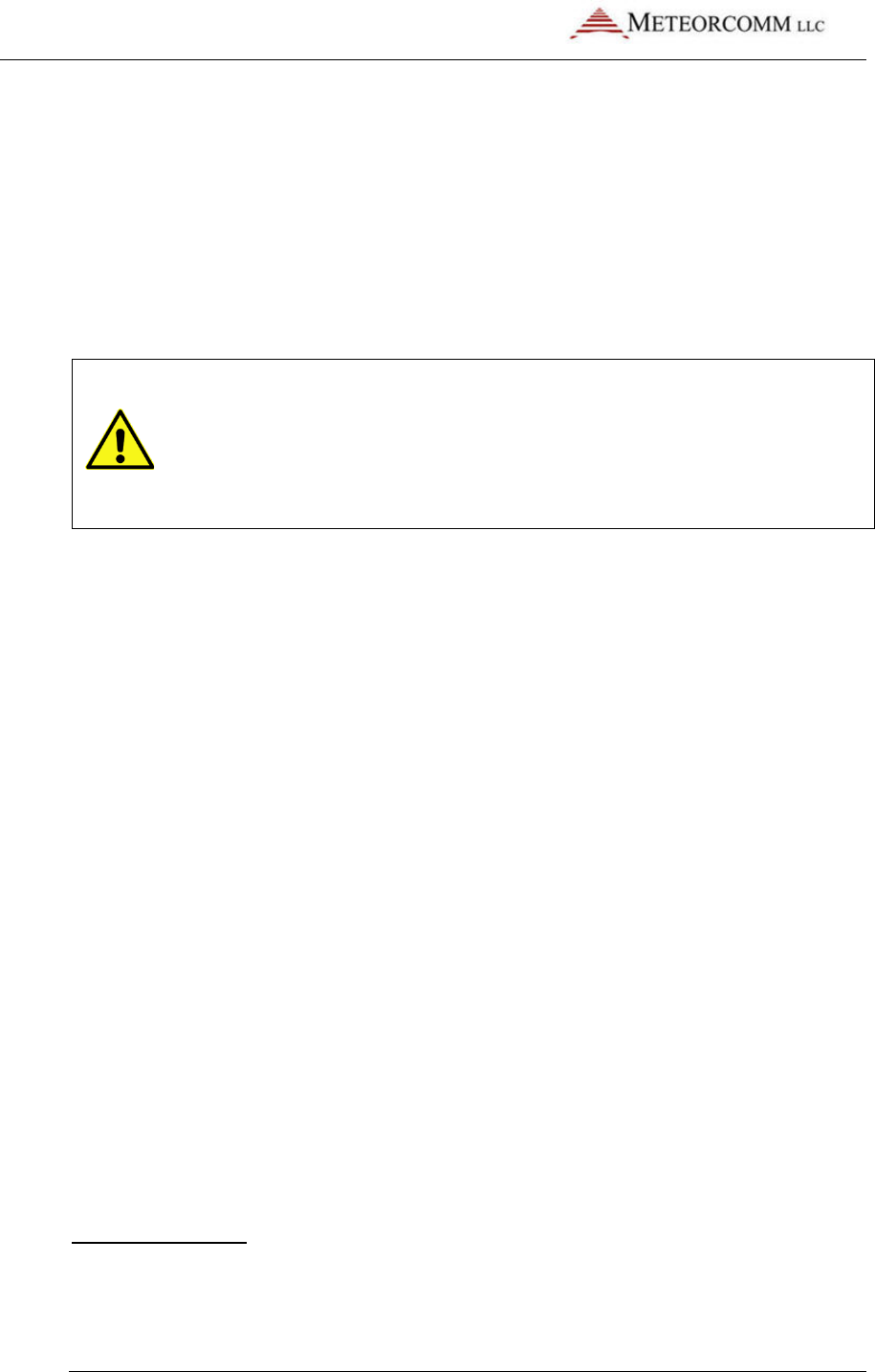
ITCR Wayside User’s Manual
© 2013 Meteorcomm LLC. All Rights Reserved. Proprietary and Confidential
6 5/16/2013
Therefore, the wayside radio may not transmit on those channels or their 221 MHz
counterparts, 361-370 and 381-385. This corresponds to wayside frequencies,
220.8125, 220.8375, 220.9125, 221.8125, 221.8375, and 221.9125 MHz.
Please refer to Part 90 Subpart T and SRSP-512 for additional frequency use
restrictions in Canadian and Mexican border areas.
3.3 Wayside Radiated Power Limits
It is the responsibility of the licensee to comply with the effective
radiated power limits based on operating frequency, geographic location,
and effective antenna height set out in 47CFR Subpart T §90.701 et. seq.,
or Industry Canada SRSP-512 §6.3, as applicable.
Important: The following supplementary antenna system information discusses
means for the licensee to determine effective radiated power (ERP) and comply with
regulatory power limits.
Licensees must comply with the specific power and antenna height limitations for
fixed-antenna stations per §90.729 or SRSP-512 §6.3. Note that U.S. and Canadian
power limits vs. HAAT are not identical.
Licensees should note that all mobiles and also fixed installations transmitting
between 221 and 222 MHz must limit effective radiated power (ERP) to 50W or
10*log(50) + 30 = 47dBm PEP referenced to the 2.15 dBi gain of a dipole, unless
operating under a waiver of FCC rule §90.729(b) or SRSP-512 §6.3 as applicable. The
EIRP for this case is 49.15 dBm. Also note that the maximum ERP on FCC/IC channels
196-200 at 220.975 to 221.000 MHz is 2 watts.
The allowable transmitter peak envelope power output in dBm is determined by
subtracting the antenna gain in dBi from 49.15, then adding the loss from the
antenna feedline and connectors. If the result is greater than or equal to 44.85 dBm
= 14.85 dBW then the maximum power output of the Wayside transmitter can be
used. If the value is less than 44.85 dBm, then the transmitter output power must be
reduced to the calculated value.
Mobile Installation: As an example of a mobile installation, consider a vertical half
wave ground plane on a vehicle metal rooftop. In an ideal installation the antenna
gain = 2.4 dBd = 4.55 dBi. Ignoring connector losses, feedline loss is at least 0.6 dB

ITCR Wayside User’s Manual
© 2013 Meteorcomm LLC. All Rights Reserved. Proprietary and Confidential
5/16/2013 7
for 10 feet of Times Microwave LMR-195 Ultra Flex coaxial cable. Transmitter power
output limit = 47-2.4+0.6 = 45.2 dBm PEP and therefore the system is compliant with
the 50W ERP limit. The actual ERP in this case is 10^(14.85+2.4-0.6) = 46.2 W. This
installation is not allowed to transmit on FCC channels 196-200 because the
maximum ERP is greater than 2 watts.
Fixed Installation: In a fixed installation, a common single-element exposed folded
dipole antenna without reflector has 0 up to 2.9 dBd (2.1 to 5.0 dBi) azimuthal gain
depending on the design.
Once the allowable ERP is determined by applying all power-restrictive rules from
above and the antenna gain is known, the transmitter peak envelope power output
feeding the transmission line is determined by subtracting the antenna gain in dBd
from the ERP and adding the loss from the antenna feedline and connectors plus the
loss from any external inline power sensors, combiners, filters or lightning arresters.
If the net value is greater than or equal to 44.85 dBm, then the maximum power of
the Wayside transmitter can be used. If the value is less than 44.85 dBm, then the
transmitter output power must be reduced to the net value.
Example for the 50W ERP fixed case: Antenna gain = 2.9 dBd and feedline loss is at
least 0.5 dB for 25 feet of Times Microwave LMR-400 coax plus 0.4 dB for inline
lightning arrester and three connectors. Assuming no other losses, the transmitter
power output limit = 47-2.9+0.9 = 45 dBm PEP. In this case, the actual Wayside ERP
is 44.85+2.9-0.9 dBm = 46.85 dBm = 48.4 W PEP and therefore the system is
compliant with the 50W ERP limit. This installation is not allowed to transmit on FCC
channels 196-200 because the maximum ERP is greater than 2 watts.
4. Setup and Configuration for the Wayside Radio
Set up physical connections with the following:
• DC Power
• Ethernet
RF output termination
The sections below identify each of the physical connections.
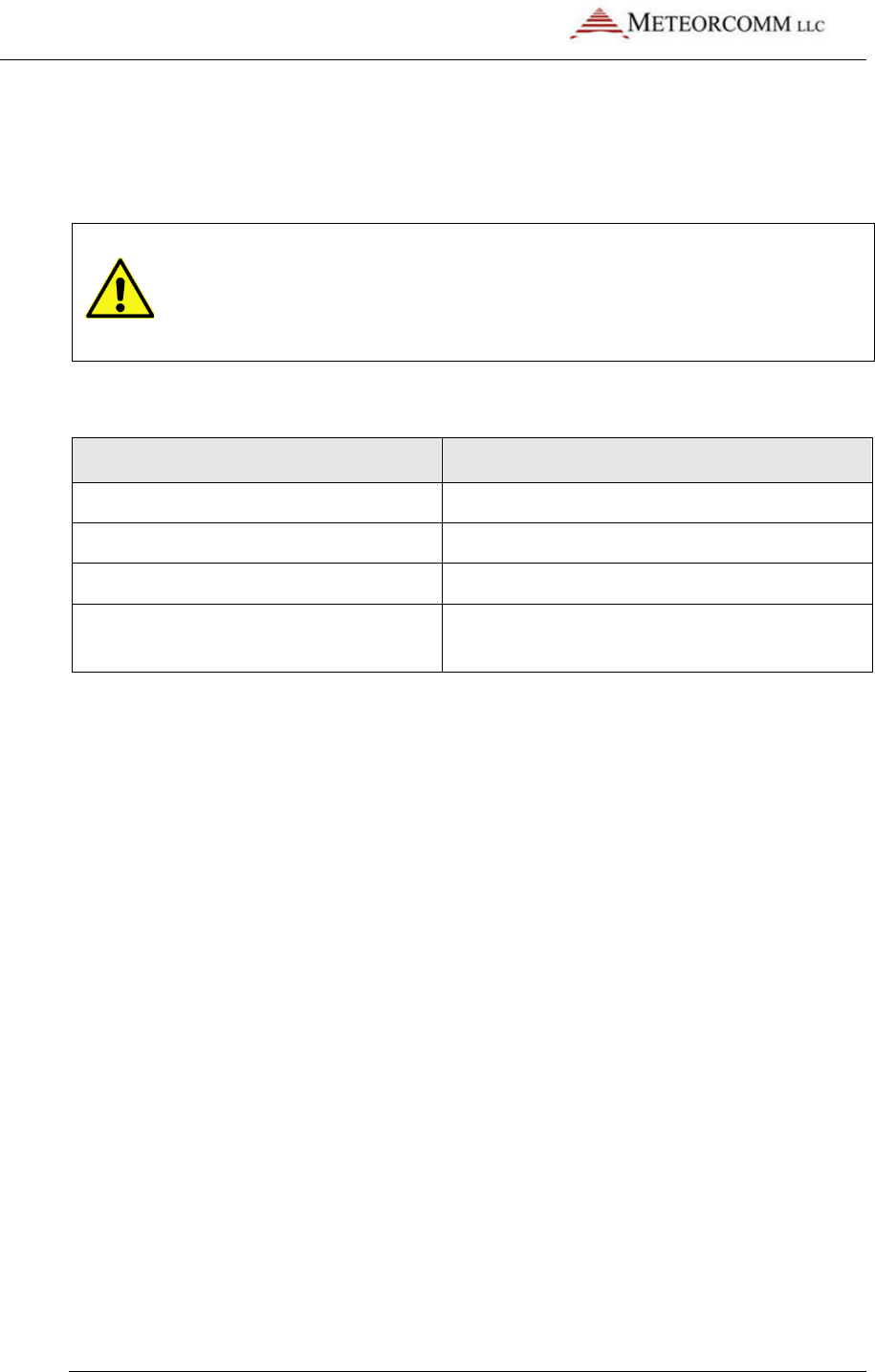
ITCR Wayside User’s Manual
© 2013 Meteorcomm LLC. All Rights Reserved. Proprietary and Confidential
8 5/16/2013
4.1 Power Supply
Wayside radios operate at 13.6Vdc input. Table 1 describes the power supply
requirements.
Caution: Applying an incorrect voltage to a Wayside radio can cause
damage. Confirm the voltage of the radio and the power supply before
applying power.
Table 1 Wayside Radio Power Parameters
Parameter Wayside Radio
Nominal DC Power Input Voltage
13.6Vdc
Operational Range
10.9-15.5Vdc (+14%/-20%)
Damage limit
17Vdc
Current Drain (while transmitting
rated power)
10A max while transmitting into 50 ohm
load
4.2 Ethernet Connection
Wayside radios use a standard CAT5 Ethernet cable connected between a PC and
the maintenance port of the radio. Configure the PC network card with a fixed IP
address of 10.10.1.254.
You will use XtermW, a Meteorcomm terminal emulation program, to connect with
and control the radio via commands issued at command prompts.
4.3 RF Output Termination
The Wayside radio is rated for 30W PEP. Sufficient termination is required to protect
test equipment. For transmitter and receiver testing, connect the test equipment to
the port labeled “ANT”. See further instructions below.

ITCR Wayside User’s Manual
© 2013 Meteorcomm LLC. All Rights Reserved. Proprietary and Confidential
5/16/2013 9
5. Tuning the Wayside Radio
There are three parameters to test and potentially tune before/during RF testing:
•
• Master reference crystal oscillator frequency
• RF output power
• RF output channel
Factory technicians tune the master reference crystal oscillator and set the RF gain
for maximum rated output power. You may have to adjust the three parameters
before or during RF testing by entering commands using XtermW or another
terminal emulation program.
5.1 Equipment Required
1. 10A DC power supply at rated voltage of wayside radio, nominally 13.6 VDC.
2. Personal computer with Ethernet network adapter and Meteorcomm XtermW
or equivalent terminal program installed.
3. 30 dB 50W RF power attenuator.
4. Vector spectrum analyzer for power and frequency measurements.
5. Optional 8+ digit frequency counter for frequency measurements.
6. High stability time base accurate to 0.1 ppm. Can be internal to items 4 and 5.
5.2 Set up the Radio for Testing
1. Adjust a 10A DC power supply to 13.6 VDC and then disable its output.
Observing polarity of the power supply terminals, connect the wayside power
cable between the radio power connector and the power supply.
2. Connect one end of a CAT5 ethernet cable to the RJ-45 radio port labeled
MAINT. Connect the other end to a computer network card. The default radio
IP address is 10.10.1.254. Set the IP address of the computer network card to a
compatible fixed address such as 10.10.1.1. The computer should have
Meteorcomm XtermW or a similar terminal emulation program installed.

ITCR Wayside User’s Manual
© 2013 Meteorcomm LLC. All Rights Reserved. Proprietary and Confidential
10 5/16/2013
3. Apply power to the radio. Wait 30 seconds to open an XtermW session. Use
the Edit/Configure Port window to set Port Type = TCP/IP, Protocol = Stream,
TCP/IP Settings Host = 10.10.1.254, Port 4000. Select Device Type = MCC 6100
SDR (which also applies to ITC radios). Return Character = CR, Data Format =
ASCII.
4. Attach a 50W 30 dB RF attenuator to the TX/RX1 N-type antenna connector.
Attach an (e.g., Agilent MXA or PXA) vector spectrum analyzer or similar to the
transmitter port for power and frequency measurements. The VSA should
contain either a precision stability reference oscillator or attach an external
rubidium reference to the VSA external reference input.
5.3 Measure and Calibrate Reference Crystal Oscillator Frequency
The instructions below allow you to change the factory calibration settings for the
master reference oscillator crystal.
To check the master reference crystal oscillator frequency calibration:
1. Open an XtermW session.
2. Put the radio into test mode by typing:
dsp,watchdog,off
dsp_mode,test
3. Reduce output power to approximately 2W by typing:
cal,set,ddslevel, 100
4. Begin transmitting a test tone directly on the carrier frequency:
l1_test,stop
l1_test,set,txmod,cw
l1_test,set,txfreq,220012500
l1_test,start,tx
5. Use the frequency counter or frequency counting marker on the VSA to
measure the output frequency. The measured value is the actual carrier
frequency. The carrier frequency is normally well within 352 Hz (1.5 ppm) of the
center frequency of the channel.
6. Alternate to the test tone: Substitute the following π/4-DQPSK modulation
command for the second line in step 4.
l1_test,set,txmod,dqpsk_half
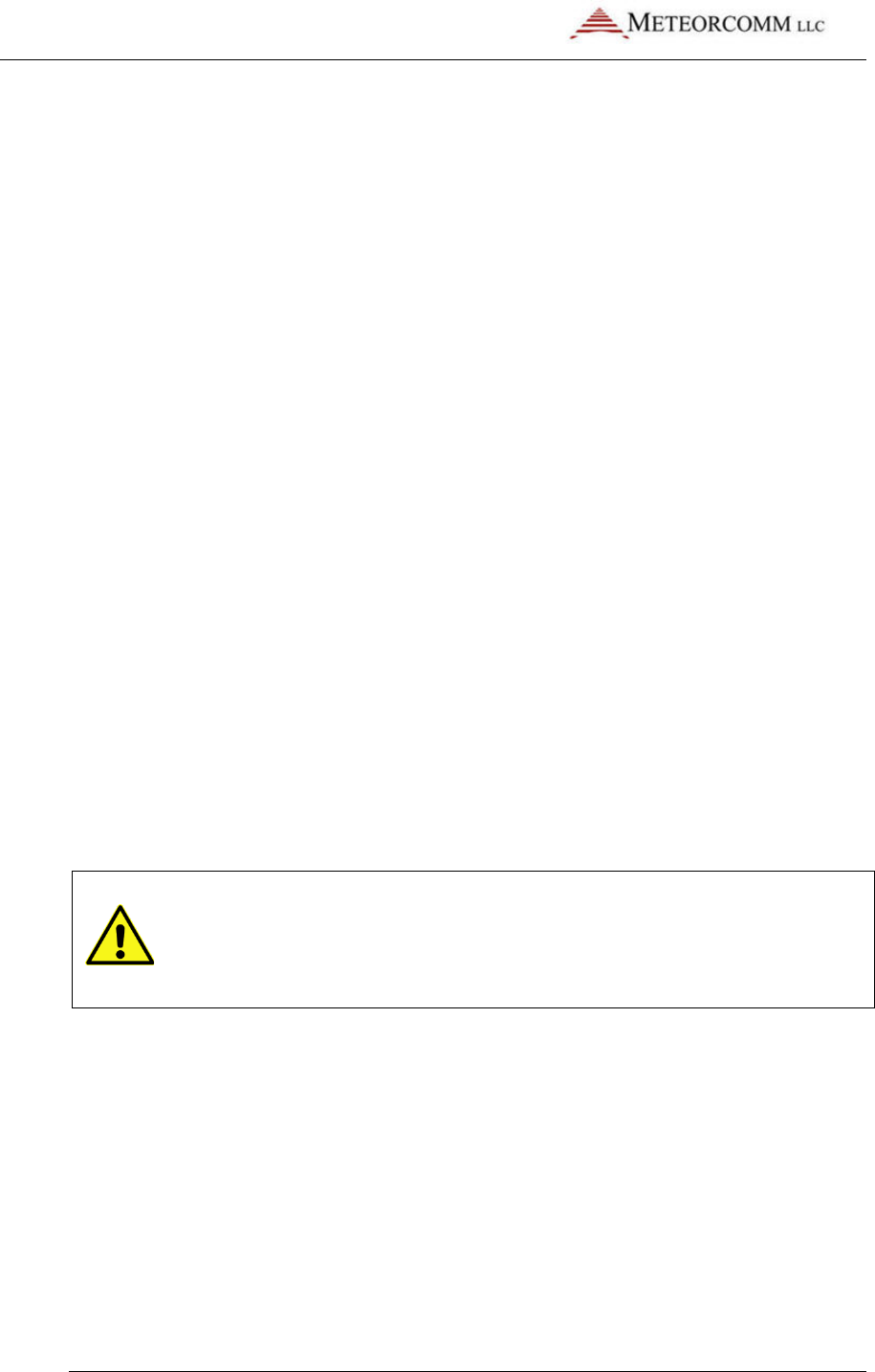
ITCR Wayside User’s Manual
© 2013 Meteorcomm LLC. All Rights Reserved. Proprietary and Confidential
5/16/2013 11
7. Set the VSA to the center frequency of the channel and set it to demodulate the
8 ksym/second π/4-DQPSK emission and measure the error frequency which is
referenced to the VSA center frequency.
To adjust the master crystal reference oscillator parameters:
1. First, check the factory default setting for the crystal reference parameter by
typing
cal
2. Note the value for “xo” in the cal factors table that is displayed.
3. At the XtermW command line, type:
cal,set,xo,xx
where xx is some value close to the original factory set value.
4. Use trial and error to determine the set point for the xo value to achieve the
desired carrier frequency accuracy.
To reset the XO tuning parameter to the factory setting:
Power cycle the radio.
5.4 Measure and Adjust Output Power
Caution: Avoid unnecessary adjustments. Exercise caution when setting
DDS level (ddslevel) or other power output controls as damage to the
radio can occur if they are set too high.
The wayside radio is rated for 30W PEP and is preset to this level at the factory. If
additional tuning is required, use an appropriate method to measure PEP for a π/4-
DQPSK signal. The CCDF function on the VSA is recommended for peak power
measurement. Slowly increase/decrease ddslevel level from its nominal set point, as
determined by issuing the command ‘cal’.
To measure and adjust output power:
1. At the XtermW command line, begin transmitting a π/4-DQPSK signal by
typing:

ITCR Wayside User’s Manual
© 2013 Meteorcomm LLC. All Rights Reserved. Proprietary and Confidential
12 5/16/2013
l1_test,stop
l1_test,set,txmod,dqpsk_half
l1_test,start,tx
2. View the calibration settings by typing:
cal
3. Observe the value for ddslevel.
4. Tune the VSA to the center of the channel frequency and select the CCDF
function to measure the peak (envelope) power, average power and peak to average
ratio. Note that the peak envelope power is used for determining ERP.
5. The power can be modified by typing:
l1_test,stop
cal,set,ddslevel,xxx
l1_test,start,tx
While monitoring the output power, the value xxx should be increased a small
amount to increase output power or vice versa.
5.5 Check and Adjust RF Output Channel
You can adjust the RF output channel by stopping transmission, setting transmission
frequency, and then starting transmission again.
To adjust RF output channel:
1. Tune the radio to the bottom channel (217.6125MHz) by typing:
l1_test,stop
l1_test,set,txfreq,217612500
l1_test,start,tx
2. Tune the radio to the mid-channel (219.8125MHz) by typing:
l1_test,stop,
l1_test,set,txfreq,219812500
l1_test,start,tx
3. Tune the radio to the high channel (221.9875MHz) by typing:
l1_test,stop
l1_test,set,txfreq,221987500
l1_test,start,tx

ITCR Wayside User’s Manual
© 2013 Meteorcomm LLC. All Rights Reserved. Proprietary and Confidential
5/16/2013 13
6. Operations
6.1 Restore Factory Settings
To restore factory settings without cycling the radio:
• At the XtermW command prompt, type:
factory
6.2 Display Software and Firmware Revision Numbers
To display what software and firmware versions are installed on your radio:
• At the XtermW command prompt, type:
rev
6.3 Display Radio Identification Information
This section provides you with commands to display serial number and identification
information.
To display serial number information:
• At the XtermW command prompt, type:
serialnumber
To show current ID setting:
• At the XtermW command prompt, type:
ID